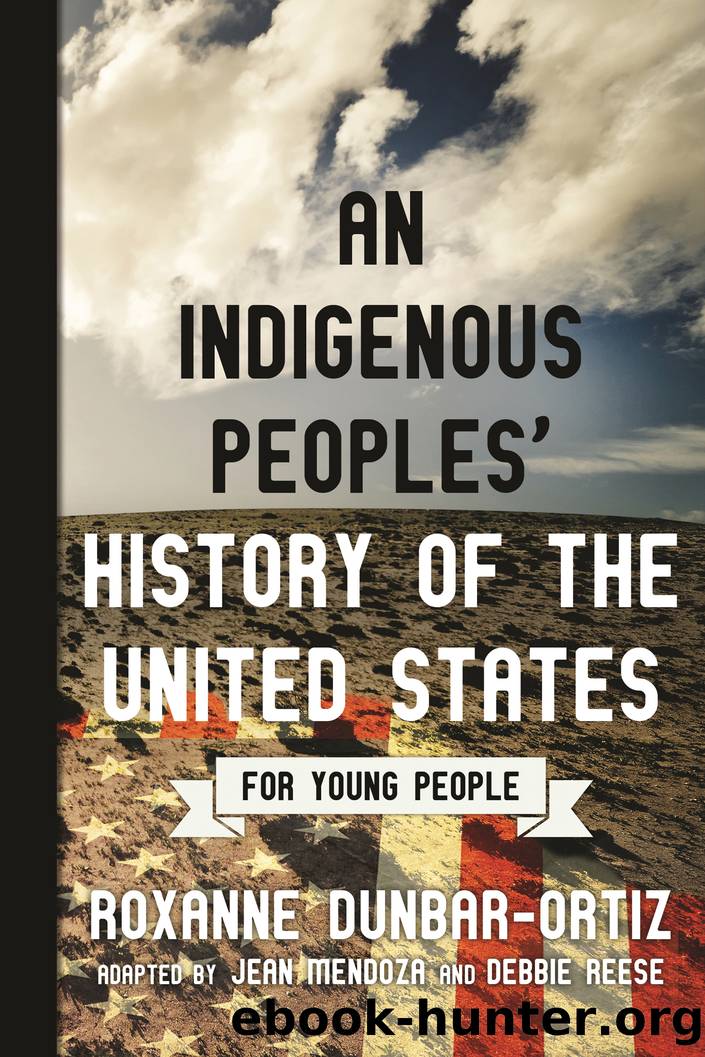An Indigenous Peoples' History of the United States for Young People by Roxanne Dunbar-Ortiz

Author:Roxanne Dunbar-Ortiz [Dunbar-Ortiz, Roxanne]
Language: eng
Format: epub
Publisher: Beacon Press
INDIGENOUS NATIONS AND THE CIVIL WAR
When the Civil War broke out, some Indigenous people hoped for a victory for the Confederate States of America, which they believed would weaken the United States and stop its takeover of their homelands. The Indigenous nations most directly affected by the war were the Cherokee, Muscogee, Choctaw, Chickasaw, and Seminole. They had rebuilt their townships, farms, ranches, schools, and governments after their removal to Indian Territory. A tiny elite of each nation owned enslaved Africans and private estates and dominated their nationsâ politics. A majority of Indigenous people wanted to stay out of the fight between North and South. But when war broke out in 1861, these tribal governments, led by their wealthiest members, exercised their status as sovereign nations by signing treaties with the Confederacy.
Nearly seven thousand Cherokee, Muscogee, Choctaw, Chickasaw, and Seminole went into battle for the Confederacy. But a few months after the war broke out, thousands of volunteers from Indian Territoryâmainly Indigenous men and self-emancipated African Americansâorganized into regiments under the command of white officers to engage and harass the Confederate Army from Oklahoma to Kansas. During the war, many Indigenous soldiers who had begun the war fighting for the Confederacy became disillusioned and went over to the Union side.
Although in Indian Territory Union forces were getting help from Indigenous volunteers against the Confederacy, in other places Lincolnâs army was at war with Indigenous peoples. For several decades, the federal government had been seizing territory that belonged to the Dakota people. In 1859 the United States turned some of their land into the state of Minnesota. Confined to reservations, the Dakota were no longer able to live and hunt freely on Minisota Makoce (Land Where the Waters Reflect the Skies or Heavens). By 1862 they were on the verge of starvation. Crops had failed and game was scarce. But most important, the federal government failed to meet many of its treaty obligations, including providing payments and supplies or keeping settlers from squatting on reservation lands.
When the Dakotas mounted an uprising to drive out the settlers, Union Army troops crushed the revolt. They rounded up thousands of men, women, children, and elders and held them at the Lower Sioux Agency in Morton, where they identified over three hundred who would be put on trial for murder. On November 7, 1862, those not destined for a courtroom in Mankato were marched over one hundred miles to Fort Snelling and imprisoned there. In Mankato, a commission of military officers heard the murder cases, sometimes reaching a verdict after only a few minutes. In all, 303 Dakota men were sentenced to death. After a review of the trial records, President Lincoln decided that thirty-nine of them should be executed. One was given a last-minute reprieve. On December 26, 1862, thirty-eight Dakota prisoners took their assigned places on a specially constructed scaffold. They grasped each othersâ hands and sang a Dakota song as they were hanged before some four thousand spectators.
It is the largest mass execution in US history.
Download
This site does not store any files on its server. We only index and link to content provided by other sites. Please contact the content providers to delete copyright contents if any and email us, we'll remove relevant links or contents immediately.
Time To Go by Time To Go (epub)(546)
Banaras: CITY OF LIGHT by Diana L. Eck(424)
Horrible Histories: The Incredible Incas by Deary Terry(366)
Where Is the Congo? by Megan Stine & Who HQ(301)
Climbing Days by Dan Richards(296)
In the Role of Brie Hutchens... by Nicole Melleby(267)
The Borribles Across the Dark Metropolis by Michael de Larrabeiti(258)
Shuri by Nic Stone(240)
An Indigenous Peoples' History of the United States for Young People by Roxanne Dunbar-Ortiz(238)
The American Girl's Handy Book by Lina Beard & ADELIA B. BEARD(227)
Strong Voices by Tonya Bolden(222)
True or False by Cindy L. Otis(221)
Brick City - London (Lonely Planet Kids) by Lonely Planet Kids(209)
The Lonely Planet Kids Travel Book by Lonely Planet Kids(206)
The Flag Book (Lonely Planet Kids) by Lonely Planet Kids(202)
Good Poems, American Places by Various(201)
City Trails - Barcelona (Lonely Planet Kids) by Lonely Planet Kids(201)
Brick City - Paris (Lonely Planet Kids) by Lonely Planet Kids(187)
America's National Parks (Lonely Planet Kids) by Lonely Planet Kids & Alexa Ward(177)
